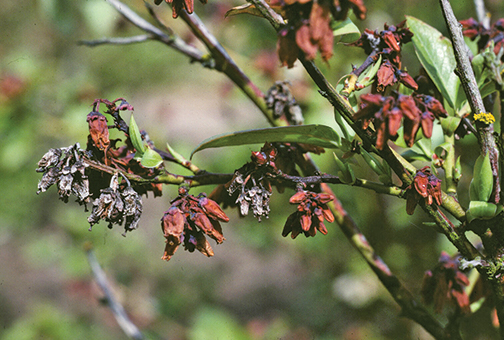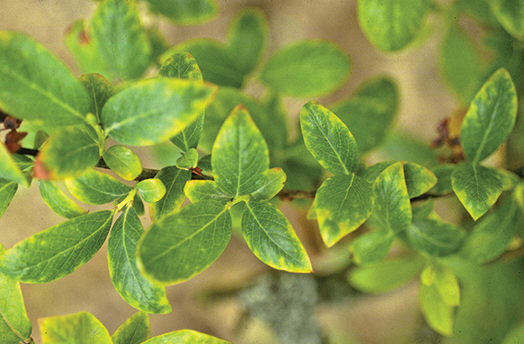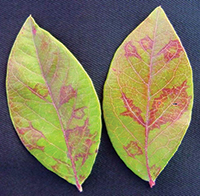Free printed copies of pest alerts are available.
Origin and Distribution
Scorch is a serious disease of blueberries (Vaccinium corymbosum) caused by blueberry scorch virus. Blueberry scorch virus has been detected in blueberry plants in northern blueberry growing states on the east and west coasts and in the Midwest. Blueberry scorch virus was initially described from plants in New Jersey in 1970, but was not identified as a viral diseases until 1980 from studies on infected plants in Washington.
The Pathogen
Blueberry scorch virus (BlScV) is a singlestranded, positive-sense RNA virus in the genus Carlavirus and family Flexiviridae. Virions are flexuous rods ca. 690 nm long and 14 nm wide. Different strains of the virus exist with the greatest virus diversity identified in British Columbia. The virus can infect highbush and rabbiteye blueberries, but has not been detected in lowbush blueberry. The virus also infects several wild Vaccinium species, some of which show symptoms similar to highbush blueberries. Infected cranberry and black huckleberry (V. membranaceum) are symptomless.

Symptoms
While all highbush blueberry cultivars are susceptible, symptom expression depends on the cultivar and virus strain. In most cultivars, infection results in blighting of flowers and leaves during the bloom period. Symptoms may be present on a few branches or the whole bush, and infected bushes may be scattered throughout the field. Blighted tissues often remain attached for a long time and turn a silvery gray if retained through the winter. Scorch may resemble frost injury, blueberry shock, Botrytis, Phomopsis or Pseudomonas twig blights. Some cultivars show mild symptoms such as chlorosis, yellow margins or red line patterns on leaves in the fall. Others remain symptomless but can still serve as virus reservoirs. Plants with necrosis symptoms have greatly reduced fruit production and shoot growth; yield losses as high as 80% have been reported. Symptoms return every year but the severity may vary. Plants with severe scorch symptoms continue to decline and may die after 3 to 6 years. No observable yield loss occurs in symptomless infected plants. Since visual symptoms are not reliable, laboratory testing is required for a proper disease diagnosis.


Biology
Infected planting material is the primary source for long-distance spread of blueberry scorch virus. The aphids Ericaphis fimbriata and Illinoia pepperi are known to spread the virus from plant to plant in a non-persistent manner. This occurs over relatively short distances, typically less than 1 mile. While feeding on infected plants, aphids pick up virus particles on their mouthparts and can transmit them for about 15 minutes. Ericaphis species are relatively inefficient vectors, but high aphid populations increase the risk of virus transmission. The rate of spread is about 4% per year in the absence of aphid control. The virus is not transmitted by contact between plants or mechanical means. Once a plant is infected, symptoms take 1 to 2 years to develop. The disease usually starts on one or two branches but eventually the entire bush becomes infected, including the roots.
Management
The introduction of the virus can be prevented by using certified virus-tested nursery stock. Visual inspection in nurseries is not sufficient as many cultivars do not show symptoms. Monitor plants closely for symptom development during bloom and mark suspicious plants. If scorch is suspected, send fresh, symptomatic plant samples to a reputable laboratory for diagnosis. Due to uneven distribution of the virus in the plant, it is advisable to take several samples from different branches.
If the percentage of infected plants in a field is high, all plants should be removed and burned. If the percentage is low, removal of infected plants combined with virus testing and aphid control can be implemented. Virus testing and aphid control should continue for at least 2 years following bush removal to ensure that the virus has been eradicated. Before bush removal, apply an insecticide to prevent dispersal of infective aphids, and a herbicide to prevent emergence of infected suckers from any roots that are left behind.
Credits
Author: Annemiek Schilder, Department of Plant Pathology, Michigan State University
The author gratefully acknowledges valuable input from Robert Martin, Peter Oudemans, James Polashock, Siva Sabaratnam, Sonja Ring, and Jay Pscheidt.
This publication was produced and distributed in cooperation with the USDA NIFA Integrated Pest Management Program, the North Central IPM Center and the Land Grant Universities.
This work is supported by the Crop Protection and Pest Management Program (2018-70006- 28884) from the USDA National Institute of Food and Agriculture.
For information about the Pest Alert program, please contact the North Central IPM Center at northcentral@ncipmc.org.
Content Updated: July 2019

